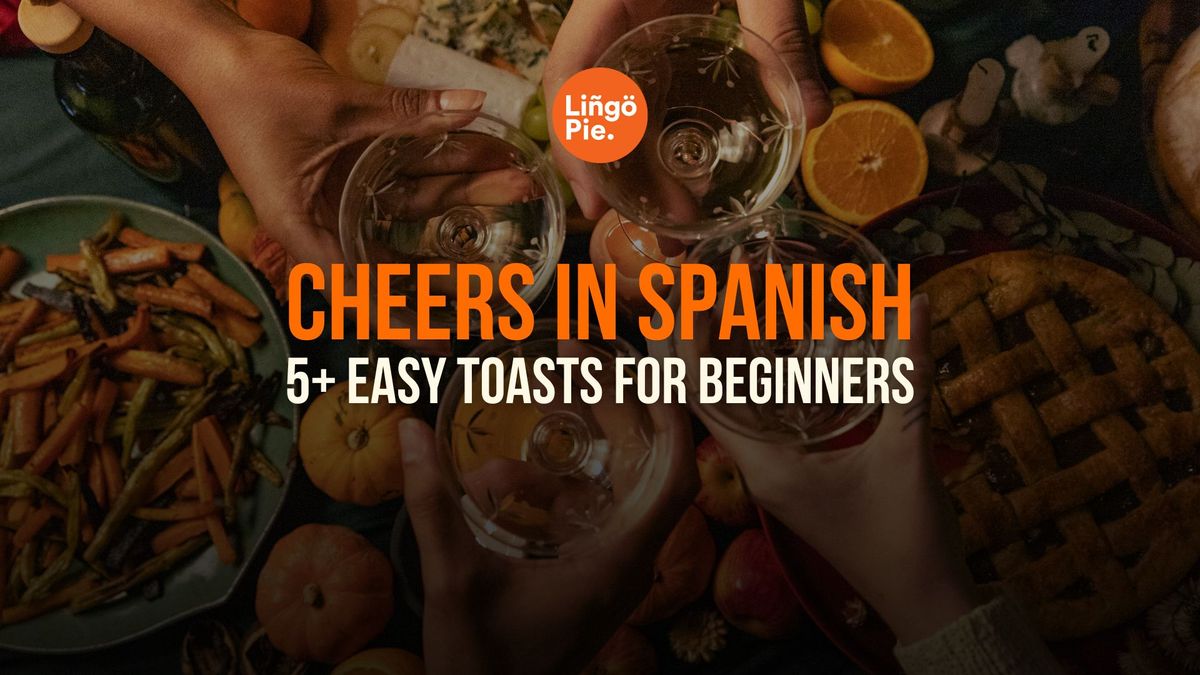I'll never forget my first night out in Barcelona - there I was, clutching my glass of rioja at a bar, completely freezing up when everyone started their toast. My Spanish friends were raising their glasses with big smiles, and I just stood there awkwardly, wishing I'd learned how to say cheers in Spanish.
After living in Spain and traveling through Latin America, I've learned that mastering a few simple Spanish toasts can transform you from a confused tourist to a welcome friend in seconds. My advice? Stick around as I'll share the best ways to say cheers in Spanish like a local.
- How To Become Fluent in Spanish: 5 Best Tips [2025]
- Spanish Curse Words: 20+ Crazy Bad Words In Spanish
- 21+ Charming Spanish Compliments to Brighten People's Day

How To Say Cheers In Spanish?
"¡Salud!" is the most common and universal way to say "cheers" in Spanish. Pronounced as "sah-LOOD," this simple word literally means "health" and works perfectly in any Spanish-speaking country or situation. It's similar to how English speakers say "to your health," but Spanish speakers have shortened it to just "health" - making it quick, easy, and impossible to mess up.
You might sometimes hear it with small variations like "¡A tu salud!" (to your health) or "¡A la salud!" (to the health), but the basic "¡Salud!" is always your safest bet. Here's how you might hear it used:
- "¡Salud!" - Cheers!
- "¡Salud, amigos!" - Cheers, friends!
- "¡A tu salud!" - To your health!
- "¡A la salud de todos!" - To everyone's health!
- "¡Brindemos con un salud!" - Let's toast with a cheers!
The beauty of "¡Salud!" is its simplicity. You don't need to worry about complex conjugations or formal versus informal situations - it works everywhere from casual beer gardens to fancy wine tastings.
Other Ways To Say Cheers In Spanish
¡Chinchín!
"¡Chinchín!" (pronounced "chin-CHIN") is the playful Spanish equivalent of "cheers" that mimics the sound of glasses clinking together. This fun, onomatopoeic toast is especially popular in Chile, Argentina, and parts of Spain, but you'll hear it all across the Spanish-speaking world. It's casual, cheerful, and perfect for informal gatherings.
- "¡Chinchín, amigos!" - Cheers, friends! (with the clinking sound)
- "¡Un chinchín por nosotros!" - A cheers for us!
- "¡Hagamos chinchín!" - Let's make a cheers!
- "¡Chinchín por el fin de semana!" - Cheers to the weekend!
This toast is particularly great for groups of friends and casual settings - it adds a bit of fun and lightness to any drinking occasion. Plus, it's practically impossible to say without smiling!

¡Por... [Name]!
"¡Por!" means "to" or "for" and is the perfect way to dedicate a toast to someone or something specific in Spanish. This versatile toast lets you customize your drinking tribute - whether you're celebrating a birthday, a promotion, or just good company. Simply add what you're celebrating after "¡Por...!" and you're good to go.
- "¡Por Juan!" - To Juan!
- "¡Por el amor!" - To love!
- "¡Por el nuevo trabajo!" - To the new job!
- "¡Por nosotros!" - To us!
- "¡Por la vida!" - To life!
Remember, when using "¡Por...!", you're essentially spotlighting what's being celebrated, so make it count and keep it relevant to the moment!
¡Arriba, abajo, al centro y pa' dentro!
This fun, rhythmic toast translates to "Up, down, center and in!" and is the Spanish equivalent of a drinking chant. Popular especially in Mexico and across Latin America, this toast is actually a set of drinking instructions: raise your glass up, lower it down, bring it to the center for clinking, and then drink up!
- Complete chant: "¡Arriba, abajo, al centro y pa' dentro!"
- Shortened version: "¡Arriba, abajo, pa' dentro!"
- With friends: "¡Arriba, abajo, al centro y pa' dentro, amigos!"
- Party version: "¡Arriba, abajo, al centro - todos pa' dentro!"
This toast is perfect for parties and group settings where you want to get everyone involved in a synchronized drinking moment.

Sant Hilari, Sant Hilari
"Sant Hilari, Sant Hilari" is a traditional Catalan toast that's specific to the Catalunya region of Spain. The phrase refers to Saint Hilary and is typically repeated twice, creating a rhythmic toast that's unique to Catalan drinking culture. While less common than other Spanish toasts, it's worth knowing if you're visiting Barcelona or other parts of Catalunya.
- "Sant Hilari, Sant Hilari!" (basic version)
- "Per Sant Hilari, Sant Hilari!" (with "per" meaning "for")
- "Un Sant Hilari per tots!" (A Sant Hilari for everyone!)
- "Sant Hilari, Sant Hilari, salut!" (combining with the traditional "salud")
While you might not use this toast outside of Catalunya, knowing it shows respect for regional traditions and can make you seem more culturally aware when drinking with Catalans!
¡Chupito!
"¡Chupito!" (pronounced "choo-PEE-toh") literally means "shot" in Spanish and has become a popular toast, especially when drinking shots or small drinks. Most common in Spain, this casual toast brings an energetic vibe to any drinking session and is perfect for those moment-before-drinking declarations.
- "¡Chupito, chupito!" (often chanted)
- "¡Venga, chupito!" - Come on, shot!
- "¡Un chupito más!" - One more shot!
- "¡Chupitos para todos!" - Shots for everyone!
This toast is especially handy at bars or clubs when you're doing shots with friends. It's casual, fun, and gets everyone excited for the drink ahead!

¡Salucita!
"¡Salucita!" is the diminutive form of "salud" and adds an extra touch of endearment to your toast. Think of it as saying "cheersie" or "little cheers" - it's cute, friendly, and adds a warm, affectionate tone to your toast. This variation is particularly popular among close friends and family.
- "¡Salucita, mi amor!" - Little cheers, my love!
- "¡Una salucita!" - A little cheers!
- "¡Salucita para todos!" - Little cheers for everyone!
- "¡Venga, salucita!" - Come on, little cheers!
The diminutive "-ita" ending makes this toast feel more intimate and playful, perfect for close-knit gatherings or when you want to add a touch of sweetness to your celebration.
How To Order Drinks In Spanish
When you're ready to order a drink in Spanish, the most basic phrase you'll need is "Quiero..." (I want) or the more polite "Me gustaría..." (I would like). But to really sound like a local, try using "Ponme..." (Get me...) or "Me pones..." (Will you get me...) - these are the casual, common ways Spanish speakers order at bars.
Remember, adding "por favor" at the end of your order will always earn you bonus points!
The best part about ordering drinks in Spanish-speaking countries is how straightforward it can be. Start with your chosen Spanish phrase, add your drink of choice, and specify any preferences about size or preparation. For example: "Me pones una cerveza bien fría, por favor" (Get me a really cold beer, please).
Here's a handy table of useful expressions you'll want to keep in your back pocket:
| Spanish Expression | English Translation | Example Usage |
|---|---|---|
| "Me pones..." | "Will you get me..." | "Me pones un vino tinto" |
| "Ponme..." | "Get me..." | "Ponme una caña" |
| "Quiero..." | "I want..." | "Quiero un mojito" |
| "Me gustaría..." | "I would like..." | "Me gustaría una sangría" |
| "¿Qué tienes de tomar?" | "What do you have to drink?" | When asking about drink options |
| "¿Cuál me recomiendas?" | "Which do you recommend?" | Asking for recommendations |
| "La cuenta, por favor" | "The bill, please" | When ready to pay |
| "Otra ronda" | "Another round" | Ordering for a group again |
| "Que sea doble" | "Make it a double" | Requesting a double serving |
| "Sin hielo" | "Without ice" | Specifying no ice |
| "Bien frío/a" | "Very cold" | Requesting a cold drink |
| "De la casa" | "House (drink)" | Asking for house wine/beer |
| "¿Tienen happy hour?" | "Do you have happy hour?" | Asking about deals |
| "Para llevar" | "To go" | For takeaway drinks |
| "Para tomar aquí" | "For here" | For drinking at the venue |

Common Drink Types in Spanish
Whether you're craving a beer or in the mood for cocktails, here's your go-to list of drinks in Spanish. I've organized them by category to make it super easy to find exactly what you're looking for. Combine these with the ordering phrases above, and you'll be all set!
Beer & Wine
You'll find Corona and Dos Equis dominating Mexican bars, while Spain swears by Estrella Damm and Mahou. For wine lovers, Spanish Rioja and Argentine Malbec are everywhere, with Chilean wineries like Concha y Toro giving them serious competition.
- una cerveza - a beer
- una caña - a draft beer (small glass, common in Spain)
- una jarra - a large beer
- un vino tinto - red wine
- un vino blanco - white wine
- un vino rosado - rosé wine
- una copa de vino - a glass of wine
- una botella de vino - a bottle of wine
Spirits & Liquors
When it comes to the strong stuff, each region has its champion: Mexico's premium tequilas like Don Julio and Patrón set the standard, while Puerto Rico's Bacardí and Cuba's Havana Club rule the rum world.
- un whisky - whiskey
- un ron - rum
- un tequila - tequila
- un vodka - vodka
- un gin tonic - gin and tonic
- un mezcal - mezcal
- un brandy - brandy
- un coñac - cognac
Cocktails
The cocktail culture varies by country, but some classics never fail: Spain's tinto de verano (a refreshing wine spritzer) flows all summer, while Mexico's micheladas (beer cocktails) and palomas (tequila and grapefruit) rule year-round.
- una margarita - margarita
- un mojito - mojito
- una piña colada - piña colada
- una sangría - sangria
- un cubalibre - rum and coke
- un daiquiri - daiquiri
- una michelada - beer cocktail (Mexico)
- un tinto de verano - wine spritzer (Spain)
Non-Alcoholic
- un café - coffee
- un refresco - soft drink
- una agua mineral - mineral water
- un zumo/jugo - juice
- una limonada - lemonade
- un té helado - iced tea
- una gaseosa - soda
- un batido - milkshake
Remember that in Spanish, all drinks take either "un" or "una" before them depending on their grammatical gender. Generally, if the word ends in 'a', use 'una', and if it ends in 'o' or another consonant, use 'un'. For example: "una cerveza" but "un vino."

Spanish Drinking And Toast Etiquette
If you think toasting is just about saying "cheers" and taking a sip, you might accidentally commit a social faux pas in Spanish-speaking countries. Drinking culture here comes with its own set of unwritten rules and traditions that locals take quite seriously.
I learned this the hard way when I once nearly took a sip before everyone had clinked glasses – the horror on my Spanish friends' faces taught me everything I needed to know about proper toasting etiquette!
- Always wait for everyone to have their drinks before starting the toast
- Make eye contact with each person as you clink glasses
- Never cross arms with someone else while toasting (it's considered bad luck)
- Don't clink with just the rim of your glass – aim for the middle or bottom
- Wait for everyone to finish clinking before taking your first sip
- Never toast with water (it's considered bad luck in many regions)
Keep the Conversation Flowing with Lingopie
why stop at toasts? If you're excited about speaking Spanish like a local, Lingopie is your next step. Our platform offers thousands of hours of Spanish TV shows and movies that'll teach you real, everyday Spanish – the kind you'll actually use at bars, restaurants, and social gatherings.
You'll learn:
- Natural conversations beyond textbook Spanish
- Spanish slang and expressions from different Spanish-speaking countries
- Cultural context that helps you connect with native speakers
- Real-life situations you'll encounter while traveling

Ready to take your Spanish beyond "¡Salud!"? Start your free trial with Lingopie today and discover how fun learning Spanish can be when you're watching what you love.






![How To Become Fluent in Spanish: 5 Best Tips [2026]](/blog/content/images/size/w1200/2023/10/444DE53E-3543-4F83-8DA7-E5BE31BAD1AA.png)



![How to Learn Spanish as An Adult [Guide]](/blog/content/images/size/w300/2025/12/How-to-Learn-Spanish-as-An-Adult.jpg)